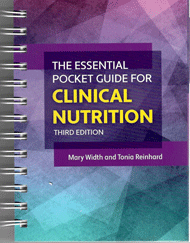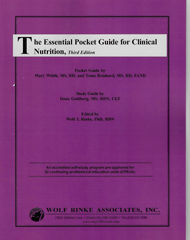The Essential Pocket Guide for Clinical Nutrition, Third Edition
| T360 |
32 CPEUs |
HARD COPY |
$239.95 |
 |
This comprehensive CPE activity provides ready access to the latest evidence-based information on nutritional assessment, nutrition support, and nutrition considerations for specific diseases such as cancer, cardiovascular disease, diabetes, and pulmonary disease. Each chapter includes sample ADIME notes and PES statements that mimic how clinicians synopsize diagnosis statements, plus sections on disease process, treatment and nutritional intervention, and patient education, making it easy to find relevant information. Master numerous competencies including how to:
- Complete a comprehensive nutrition assessment on patients in a variety of age groups, life cycle stages, and with a variety of medical or nutrition conditions.
- Calculate enteral and parenteral protocols to meet patients’ needs.
- Assess patient lab results and use lab data to make nutrition recommendations.
- Plan menus per the nutrition diagnoses and interventions for various disease states.
- Provide recommendations to other members of the healthcare team.
Share with a friend and Save! Click here for important information about
sharing.
To order an ADDITIONAL Reporting Form click below:
| T360F |
32 CPEUs |
REPORTING FORM |
$70.00 |
 |
The Essential Pocket Guide for Clinical Nutrition, Third Edition
© 2024 Wolf Rinke Associates. All rights reserved for this
self-directed accredited learning activity. Reproduction in whole or
part without written permission, except for brief excerpts, is prohibited.
LEARNING OBJECTIVES
Upon successful completion of this CPE activity, you will be better able to:
- Assess disease pathophysiology of several different organ systems.
- Identify the nutrition implications are for various pathologies.
- Complete a comprehensive nutrition assessment on patients in a variety of age groups, life cycle stages, and with a variety of medical or nutrition conditions.
- Calculate anthropometric and nutritional needs for both adults and children.
- Calculate enteral and parenteral protocols to meet patients’ needs.
- Identify a high-priority nutrition diagnosis based on the nutrition assessment.
- Recommend a variety of nutrition treatments and interventions based on the nutrition diagnoses.
- Assess patient lab results and use lab data to make nutrition recommendations.
- Interpret nutrition-focused physical exam findings to assess for malnutrition.
- Plan menus per the nutrition diagnoses and interventions for various disease states.
- Provide nutrition supplement recommendations based on the nutrition diagnoses.
- Evaluate the scientific validity and evidence behind nutrition interventions.
- Provide recommendations to other members of the healthcare team to enhance a patients’ care when it is outside the scope of practice for Registered Dietitians.
Return to the top of page
If you prefer to order by phone, mail
or fax click below
or click here to contact us with
other questions.
For information about our other products and
services return to the sidebar at the top of the page.
|



